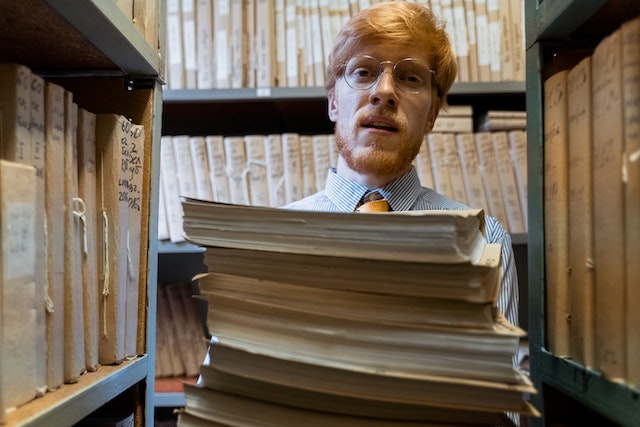Why You Never Want to Set the Comfort Trap
My experience consulting over the years with thousands of attorneys who practice in firms of all shapes and sizes across the U.S. has taught me that...
We've crafted solutions tailored to your firm
The world of insurance for law firms can be confusing, and difficult to navigate. We've created this glossary because these common insurance terms should be easy to understand.
4 min read
 Mark Bassingthwaighte, Risk Manager
:
Updated on March 7, 2024 | Posted on May 17, 2016
Mark Bassingthwaighte, Risk Manager
:
Updated on March 7, 2024 | Posted on May 17, 2016

Updated August 2023
This question is the one question I’m asked more than any other and I get it. Although my wife is a physician, she had to deal with the same issue. We were paying to store her closed files for years after she left private practice and we both breathed a sigh of relief when that last bill finally came. Truth be told, for attorneys the answer to this question isn’t a simple one; but it is manageable, and it begins with determining when any given file can be destroyed.
While guidelines and ethical opinions, formal or otherwise, differ and you should always check with the powers that be in the jurisdiction in which you practice, most recommend a retention period of seven to ten years. Speaking as a risk manager working for a malpractice insurance company, I lean toward the shorter end of this window and feel comfortable with the seven-year time frame for most files. So, if seven years have not yet passed, keep the file.
I will share that I have worked with a few firms that have far more aggressive destruction practices, several of whom destroy all files within several months to one year of being closed. I strongly advise against doing something similar if for no other reason than if a malpractice claim were ever to arise, you would have no file with which to defend yourself. That’s not a position you ever want to find yourself in. Trust me on that one.
Unfortunately, once the seven years have passed on any given file you still may not be able to destroy it. As with so many rules, there are exceptions that require an additional amount of storage time. These exceptions include but are not necessarily limited to the following:
Files involving a client who was and still is a minor;
In a perfect world, and with the above exceptions in mind, every file should have been given a destruction date or a review for destruction date when the file was first closed. If that didn’t occur, keep these exceptions in mind as you now seek to determine which files can and which files can’t be destroyed.
For those files that that are cleared for destruction, I would recommend that one final file review occur before doing so. This final file review process is intended to prevent a file from being prematurely destroyed and also assures that any remaining documents in these files that should not be destroyed are preserved. For example, when any given file was first closed, someone should have separated out all of the original documents that belonged to the client and returned them at that time. If that didn’t happen, make sure that it occurs during this final pre-destruction review. The goal is to identify and preserve the following: documents that clearly or probably belong to the client; all original documents; any other documents that the client may need or reasonably might expect his lawyer to preserve; and every file’s letter of closure.
The letter of closure is an important document to retain because it can help clarify whether or not a conflict of interest is in play later on. If closure letters are destroyed, you take away your ability to provide documentation that an inactive client is actually a past client under Rule 1.9 of the Rules of Professional Conduct, also known as the “Former Client” Rule.
To varying degrees in most jurisdictions, the file is viewed as client property. This means clients should be made aware of and give their permission to have their property destroyed. If your clients were never informed of your file retention and destruction policy at the time their file was closed, an effort should be made to contact them now in order to see if they want their file.
While some attorneys try sending letters to the last known addresses of these clients, on older files this approach often proves less than fruitful. In light of the problem of trying to locate clients on files closed years ago, many firms now place in their engagement and/or closure letters a short paragraph that discloses their firm’s file retention policy as a way to solve the problem at least on a going forward basis. If you wish to do something similar, I can offer the following sample file retention language that can be inserted into your closure letters.
I have enclosed your original documents as I no longer need to keep them, and I thought you would want them for your records. It is our firm’s practice to destroy files [number of] years after we close them. If you would like us to return your file to you [number of] years from now instead of destroying it, please send me a note to that effect within the next thirty days so that we can segregate your file from all our other files and accommodate your request. You will need to be responsible for keeping us informed as to how to reach you should your contact information ever change.
If you find yourself needing to send past clients a letter years after closing their files, you might consider designing a letter based upon this sample language.
Our policy is to destroy files [number of] years after they are closed. We have retained your file for that period of time and are now preparing to have it destroyed. If your desire is to have our firm continue to store it or see that it is returned to you, you must send me a letter telling us of your desire and this must be done no later than ten days after the date you receive this letter.
Once you determine which files can be destroyed, please follow through and see that these files are properly destroyed. “Destruction” does not mean tossing all the old files in a dumpster out back and, yes, this does need to be said. Take the necessary steps to have old files incinerated or shredded. You cannot compromise your client’s confidences, even during the file destruction process.
The final step in all this is to create and keep an inventory of the final disposition of all files. At a minimum you want to track the client's name, file matter, method of disposition (destroyed, returned), and date of disposition.
Now, one side note. I am finding that some firms have decided to more or less keep client files indefinitely because virtual storage is so cheap. They will scan, then destroy the hard copy and keep the digital copy. On the surface this may seem like an easy answer but remember that as computer hardware and related storage devices are replaced over the years, the digital data on these devices must still be reviewed in order to ensure that certain data isn’t prematurely lost. Once that’s been accomplished, make certain to follow through on properly destroying your digital files. You can’t just give this stuff away or recycle it without wiping the data off the drives. The bottom line is that the issues remain the same regardless of whether your files are paper or virtual.
Since 1998, Mark Bassingthwaighte, Esq. has been a Risk Manager with ALPS, an attorney’s professional liability insurance carrier. In his tenure with the company, Mr. Bassingthwaighte has conducted over 1200 law firm risk management assessment visits, presented over 600 continuing legal education seminars throughout the United States, and written extensively on risk management, ethics, and technology. Mr. Bassingthwaighte is a member of the State Bar of Montana as well as the American Bar Association where he currently sits on the ABA Center for Professional Responsibility’s Conference Planning Committee. He received his J.D. from Drake University Law School.

My experience consulting over the years with thousands of attorneys who practice in firms of all shapes and sizes across the U.S. has taught me that...

Over the years, I have found that the use of closure letters varies greatly, not only between firms, but even between attorneys practicing at the...

3 min read
I suspect more than a few law firms, particularly in the solo/small firm space, have yet to take the necessary time to draft and write up a...